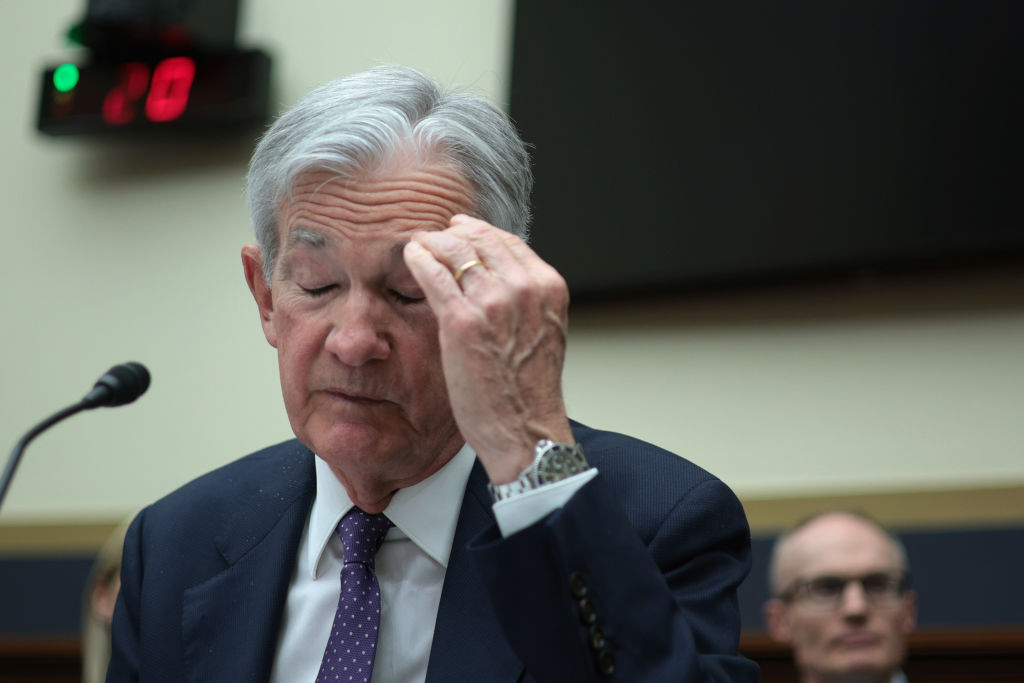Bitcoin is down more than 50% since its all-time high. What is going on?
Bitcoin, the world's most popular cryptocurrency, is trading more than 50% below its all-time high in November. Saloni Sardana explains why the digital currency is in freefall.


Bitcoin has plummeted to its lowest point in nearly six months, with most other cryptocurrencies down heavily too.
The best-known cryptocurrency rose by 57% in 2021 alone. Yet it has been in freefall in recent days and is down more than 50% since hitting an all-time high of around $68,000 late last year.
At the time of writing, bitcoin is trading 7% lower, marginally above its session and six-month low of $33,051. Meanwhile ether is down 10%, cardano down 12% and Solana down 17%.
MoneyWeek
Subscribe to MoneyWeek today and get your first six magazine issues absolutely FREE

Sign up to Money Morning
Don't miss the latest investment and personal finances news, market analysis, plus money-saving tips with our free twice-daily newsletter
Don't miss the latest investment and personal finances news, market analysis, plus money-saving tips with our free twice-daily newsletter
What is going on? Why are cryptocurrencies taking such a big hit?
Federal Reserve’s hawkishness is bad news for crypto
Bitcoin and a raft of other cryptos have not been immune to the slide in “jam tomorrow” assets seen in recent days, which is partly due to the Federal Reserve sounding much more concerned about inflation and much more willing to raise interest rates (my colleague John wrote this morning about why these story stocks have been on a downward spiral).
US inflation figures hit 7% in December, the highest level since 1982. As a result, the Fed has made a number of hawkish announcements in recent weeks, including signalling that it may unwind its unprecedented pandemic-era monetary policy more quickly than expected. Investors now expect the Fed to raise interest rates up to four times this year.
This has prompted investors to sell assets, including bitcoin, and the tech-heavy US Nasdaq (the US tech index which has been a barometer for the recent bull phase is now down 15% compared to its all-time high in November).
Bitcoin is not digital gold
Over the years, investors have flocked to bitcoin and other cryptos, attracted by soaring returns. But while proponents of bitcoin specifically have long boasted about the cryptocurrency’s “safe haven status” and its ability to serve as a hedge against inflation – it’s been described as “gold 2.0” by some – in reality, the digital currency has acted more like a risk asset than a safe haven, says Katie Stockton of technical analysis firm Fairlead Strategies.
Indeed, Stockton notes the correlation between Cathie Wood’s Ark Innovation exchange-traded fund (ARKK) – which owns the most speculative stocks in the market – and bitcoin is rather high.
“The correlation between bitcoin and high-growth benchmark ARKK still stands at ~60% year-to-date, versus ~14% for the price of gold, reminding us to categorize bitcoin and altcoins as risk assets rather than safe havens,” she said in a Friday note, reports Markets Insider.
(Charlie Morris of ByteTree has written about the complementary but different nature of gold and bitcoin for MoneyWeek in the past.)
In recent days, whenever bitcoin or ether took a hit, other cryptocurrencies – known as “altcoins” – often held up. For example, Cardano and Solana, the world’s sixth and eighth largest cryptocurrency by market cap, have both been touted as “ethereum killers”. But Monday’s brutal sell-off didn’t even spare those, with ADA and SOL leading the losses, both down 12% and 17% respectively.
All eyes are on the Federal Reserve meeting
The crypto market is eagerly awaiting the results of this week’s Fed meeting, when the Federal Open Market Committee (FOMC) will meet for the first time this year. Crypto investors will be scanning for clues as to just how aggressive the central bank plans to be this year.
Naeem Aslam, chief market analyst at online forex Avatrade reckons there is further pain ahead for crypto. “Washington is planning to release its plan for dealing with cryptocurrencies as early as February and will ask authorities to begin weighing the benefits of the digital sector against its potential threats”.
The White House is preparing to release an “initial government-wide strategy” for digital assets as soon as next month to assess their risks and opportunities, something which may pave the way for further scrutiny of the sector, Bloomberg reported Friday.
In the past year, the crypto market has seen regulators around the world, mostly notably China, introduce tougher measures and even banning cryptocurrency mining, the process by which new cryptos are created.
Prior to the ban, 65% of the world’s crypto mining took place in China. Last week, Russia announced it may follow suit. While none of these factors is likely to help the crypto market, the current sell-off appears to be more influenced by investors pivoting away from risky assets than by policy news.
Get the latest financial news, insights and expert analysis from our award-winning MoneyWeek team, to help you understand what really matters when it comes to your finances.
Saloni is a web writer for MoneyWeek focusing on personal finance and global financial markets. Her work has appeared in FTAdviser (part of the Financial Times), Business Insider and City A.M, among other publications. She holds a masters in international journalism from City, University of London.
Follow her on Twitter at @sardana_saloni
-
 The most influential people of 2025
The most influential people of 2025Here are the most influential people of 2025, from New York's mayor-elect Zohran Mamdani to Japan’s Iron Lady Sanae Takaichi
-
 Millions of parents are missing out on up to £720 a year in extra pension cash – are you affected?
Millions of parents are missing out on up to £720 a year in extra pension cash – are you affected?A mum who narrowly missed out on the pension boost said she “never knew the government rule existed” and wants other parents to use it
-
 The challenge with currency hedging
The challenge with currency hedgingA weaker dollar will make currency hedges more appealing, but volatile rates may complicate the results
-
 What's behind the big shift in Japanese government bonds?
What's behind the big shift in Japanese government bonds?Rising long-term Japanese government bond yields point to growing nervousness about the future – and not just inflation
-
 Can Donald Trump fire Jay Powell – and what do his threats mean for investors?
Can Donald Trump fire Jay Powell – and what do his threats mean for investors?Donald Trump has been vocal in his criticism of Jerome "Jay" Powell, chairman of the Federal Reserve. What do his threats to fire him mean for markets and investors?
-
 Freetrade’s new easy-access funds aim to beat top savings rates
Freetrade’s new easy-access funds aim to beat top savings ratesFreetrade has launched an easy-access exchange traded fund (ETF) range - here’s how the ETFs work and how they compare to the savings market
-
 Go for value stocks to insure your portfolio against shocks, says James Montier
Go for value stocks to insure your portfolio against shocks, says James MontierInterview James Montier, at investment management group GMO, discusses value stocks and slow-burn Minsky moments with MoneyWeek.
-
 Halifax: House price slump continues as prices slide for the sixth consecutive month
Halifax: House price slump continues as prices slide for the sixth consecutive monthUK house prices fell again in September as buyers returned, but the slowdown was not as fast as anticipated, latest Halifax data shows. Where are house prices falling the most?
-
 Rents hit a record high - but is the opportunity for buy-to-let investors still strong?
Rents hit a record high - but is the opportunity for buy-to-let investors still strong?UK rent prices have hit a record high with the average hitting over £1,200 a month says Rightmove. Are there still opportunities in buy-to-let?
-
 Pension savers turn to gold investments
Pension savers turn to gold investmentsInvestors are racing to buy gold to protect their pensions from a stock market correction and high inflation, experts say
